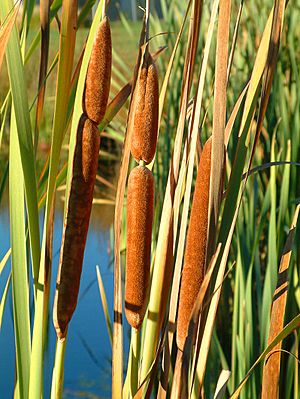Typha orientalis facts for kids
Typha orientalis, also known as bulrush or cumbungi, is a common plant found in wet areas. It's a type of plant that lives for many years (a perennial plant) and has soft, green stems instead of woody ones (a herbaceous plant). It belongs to the Typha group of plants.
This plant grows naturally in many parts of the world. You can find it in Australia, New Zealand, Malaysia, Indonesia, Japan, Korea, Mongolia, Myanmar, the Philippines, China, and even in the far eastern parts of Russia like Sakhalin and Primorye.
Typha orientalis loves water! It's a wetland plant, which means it grows best in places with lots of water. You'll often see it on the edges of ponds, lakes, and slow-moving rivers and streams.
Quick facts for kids Typha orientalis |
|
|---|---|
 |
|
| Leaves and flower spikes of Typha orientalis | |
| Conservation status | |
| Scientific classification | |
| Genus: |
Typha
|
| Species: |
orientalis
|
| Synonyms | |
|
|
How People Use Bulrush
This plant has been very useful to people for a long time.
Traditional Uses by Māori People
In New Zealand, Typha orientalis is called raupō. The Māori found many ways to use this plant:
- Food: They cooked and ate the underground stems, called rhizomes. They also baked the flowers into cakes.
- Building Materials: The long leaves were used to make roofs and walls for their houses.
- Crafts: Sometimes, the leaves were even used to make sails for their canoes (boats) and to build kites.
The Māori people also brought this plant to the Chatham Islands, where it continued to be a valuable resource.



